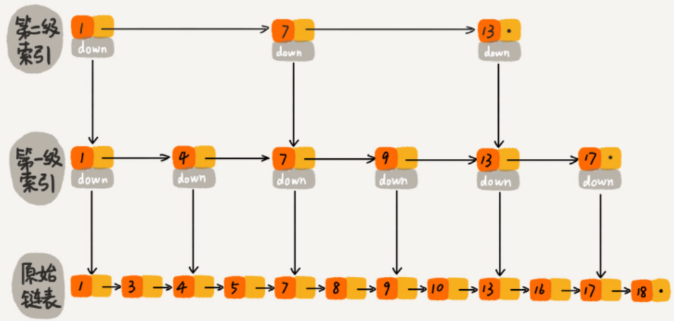
前言
在頭條創作了一個月左右的時間,收獲了50+粉絲,很是開心,我會把數據結構與算法的文章更新到底,第一次看我文章的同仁如果覺得不錯的話就關注一下我哦,你的支持就是我創作的動力。
一、什么是跳表
我們在之前介紹了十分優秀的二分查找算法,但是它只能作用于有序數組上,查找起來比較方便,但是數組中插入和刪除元素是比較麻煩的;那么有沒有辦法讓二分查找也能作用于有序鏈表上,從而達到查找、插入和刪除元素都十分的快速呢?
對于普通的有序列表來說,當然不能實現我們的目標,如下查找的時間復雜度為O(n);

原始有序單鏈表
我們可以基于原始鏈表建立一個 索引層,比如每兩個節點提取一個節點到索引層:

帶一級索引的跳表
如此,兩種數據結構我們查找元素16的比較次數分別為10次和8次,確實能提高查詢速度;我們更近一步,再次建立第二級索引:

帶二級索引的跳表 帶二級索引的跳表
此時查找元素16比較的次數只需要比較7次即可;
如果在大數據量的有序鏈表中,我們建立很多層索引,使得最高層索引只有兩個節點,那么就實現了類似二分查找的算法思想,此時這種數據結構就被成為跳表。
二、跳表性能分析
2.1 時間復雜度
假設有序鏈表總節點個數為n,我們建立索引時每兩個節點提取一個索引節點;那么第一級索引共有n/2個節點;
第k級索引共有(n/2^k)個節點,假設k為最高級索引,為2個節點,那么2=(n/2^k),n=2(k+1),k=logn-1,如果原始鏈表也算進去的話,k=logn正好是整個數據結構的高度。
假設每一層需要遍歷m個節點,那么時間復雜度就可以表示為O(mlogn),但是推斷m是常量級別的,因此可以忽略,那么整個查找過程時間復雜度就是O(logn),竟然和二分查找是一樣的高效!
2.2 空間復雜度
第一級索引需要n/2個節點,第二級需要n/2^2個節點,依次類推,第k級索引需要的節點個數為n/2^k,這正好是一個等比數列,等比數列求和的結果是n-2,所以空間復雜度為O(n),這是一個以空間換時間的策略;
我們可以每3個節點或者每4個節點往上提取一個索引節點,如此可以適當減少需要的額外空間,但是空間復雜度仍然為O(n);如果有序鏈表存儲的是大對象,那么索引節點中無需存放整個大對象,只要存儲對象的指針即可,所以此時空間復雜度就顯得不那么重要了;
2.3 跳表的插入和刪除
跳表因為是順序鏈表,所以真正插入和刪除的時間復雜度都是O(1),但是找到需要插入節點的位置或者找到待刪除的節點時間復雜度為O(logn);
跳表在刪除的時候,除了需要刪除原始有序鏈表中的節點,還需要同步刪除k級索引中的全部該索引節點;
跳表在插入元素式,極端情況下會導致兩個索引節點中存在大量的原始節點,時間效率極有可能會退化為單鏈表的O(n),所以需要動態地平衡和更新k級索引節點;
三、跳表使用場景
redis在存儲有序集合的時候就用到了跳表+散列表的數據結構,跳表和紅黑樹相比,插入、刪除、查找的時間復雜度相同,但是跳表在按照區間查找時明顯具有效率優勢,而且跳表實現起來比紅黑樹要簡單易懂,不容易出錯。
紅黑樹等常用數據結構在程序語言中都是封裝好的,我們想用的話直接拿來用即可,比如HashMap,但是跳表卻沒有對應的封裝好的數據結構,想用的話開發者必須自己去實現。
四、代碼實現跳表Skiplist以及優化
代碼來源于極客時間《數據結構和算法之美》
github地址:
https://github.com/wangzheng0822/algo(數據結構和算法必知必會的50個代碼實現)
4.1 作者王爭給出的跳表實現方式
/**
* 跳表的一種實現方法。
* 跳表中存儲的是正整數,并且存儲的是不重復的。
*
*/
public class SkipList {
private static final float SKIPLIST_P = 0.5f;
private static final int MAX_LEVEL = 16;
private int levelCount = 1;
private Node head = new Node(); // 帶頭鏈表
public Node find(int value) {
Node p = head;
for (int i = levelCount - 1; i >= 0; --i) {
while (p.forwards[i] != null && p.forwards[i].data < value) {
p = p.forwards[i];
}
}
if (p.forwards[0] != null && p.forwards[0].data == value) {
return p.forwards[0];
} else {
return null;
}
}
public void insert(int value) {
int level = randomLevel();
Node newNode = new Node();
newNode.data = value;
newNode.maxLevel = level;
Node update[] = new Node[level];
for (int i = 0; i < level; ++i) {
update[i] = head;
}
// record every level largest value which smaller than insert value in update[]
Node p = head;
for (int i = level - 1; i >= 0; --i) {
while (p.forwards[i] != null && p.forwards[i].data < value) {
p = p.forwards[i];
}
update[i] = p;// use update save node in search path
}
// in search path node next node become new node forwords(next)
for (int i = 0; i < level; ++i) {
newNode.forwards[i] = update[i].forwards[i];
update[i].forwards[i] = newNode;
}
// update node hight
if (levelCount < level) levelCount = level;
}
public void delete(int value) {
Node[] update = new Node[levelCount];
Node p = head;
for (int i = levelCount - 1; i >= 0; --i) {
while (p.forwards[i] != null && p.forwards[i].data < value) {
p = p.forwards[i];
}
update[i] = p;
}
if (p.forwards[0] != null && p.forwards[0].data == value) {
for (int i = levelCount - 1; i >= 0; --i) {
if (update[i].forwards[i] != null && update[i].forwards[i].data == value) {
update[i].forwards[i] = update[i].forwards[i].forwards[i];
}
}
}
while (levelCount>1&&head.forwards[levelCount]==null){
levelCount--;
}
}
// 理論來講,一級索引中元素個數應該占原始數據的 50%,二級索引中元素個數占 25%,三級索引12.5% ,一直到最頂層。
// 因為這里每一層的晉升概率是 50%。對于每一個新插入的節點,都需要調用 randomLevel 生成一個合理的層數。
// 該 randomLevel 方法會隨機生成 1~MAX_LEVEL 之間的數,且 :
// 50%的概率返回 1
// 25%的概率返回 2
// 12.5%的概率返回 3 ...
private int randomLevel() {
int level = 1;
while (Math.random() < SKIPLIST_P && level < MAX_LEVEL)
level += 1;
return level;
}
public void printAll() {
Node p = head;
while (p.forwards[0] != null) {
System.out.print(p.forwards[0] + " ");
p = p.forwards[0];
}
System.out.println();
}
public class Node {
private int data = -1;
private Node forwards[] = new Node[MAX_LEVEL];
private int maxLevel = 0;
@Override
public String toString() {
StringBuilder builder = new StringBuilder();
builder.Append("{ data: ");
builder.append(data);
builder.append("; levels: ");
builder.append(maxLevel);
builder.append(" }");
return builder.toString();
}
}
}
4.2 作者ldb基于王爭的代碼給出的優化
import JAVA.util.Random;
/**
* 1,跳表的一種實現方法,用于練習。跳表中存儲的是正整數,并且存儲的是不重復的。
* 2,本類是參考作者zheng ,自己學習,優化了添加方法
* 3,看完這個,我覺得再看ConcurrentSkipListMap 源碼,會有很大收獲
*/
public class SkipList2 {
private static final int MAX_LEVEL = 16;
private int levelCount = 1;
/**
* 帶頭鏈表
*/
private Node head = new Node(MAX_LEVEL);
private Random r = new Random();
public Node find(int value) {
Node p = head;
// 從最大層開始查找,找到前一節點,通過--i,移動到下層再開始查找
for (int i = levelCount - 1; i >= 0; --i) {
while (p.forwards[i] != null && p.forwards[i].data < value) {
// 找到前一節點
p = p.forwards[i];
}
}
if (p.forwards[0] != null && p.forwards[0].data == value) {
return p.forwards[0];
} else {
return null;
}
}
/**
* 優化了作者zheng的插入方法
*
* @param value 值
*/
public void insert(int value) {
int level = head.forwards[0] == null ? 1 : randomLevel();
// 每次只增加一層,如果條件滿足
if (level > levelCount) {
level = ++levelCount;
}
Node newNode = new Node(level);
newNode.data = value;
Node update[] = new Node[level];
for (int i = 0; i < level; ++i) {
update[i] = head;
}
Node p = head;
// 從最大層開始查找,找到前一節點,通過--i,移動到下層再開始查找
for (int i = levelCount - 1; i >= 0; --i) {
while (p.forwards[i] != null && p.forwards[i].data < value) {
// 找到前一節點
p = p.forwards[i];
}
// levelCount 會 > level,所以加上判斷
if (level > i) {
update[i] = p;
}
}
for (int i = 0; i < level; ++i) {
newNode.forwards[i] = update[i].forwards[i];
update[i].forwards[i] = newNode;
}
}
/**
* 優化了作者zheng的插入方法2
*
* @param value 值
*/
public void insert2(int value) {
int level = head.forwards[0] == null ? 1 : randomLevel();
// 每次只增加一層,如果條件滿足
if (level > levelCount) {
level = ++levelCount;
}
Node newNode = new Node(level);
newNode.data = value;
Node p = head;
// 從最大層開始查找,找到前一節點,通過--i,移動到下層再開始查找
for (int i = levelCount - 1; i >= 0; --i) {
while (p.forwards[i] != null && p.forwards[i].data < value) {
// 找到前一節點
p = p.forwards[i];
}
// levelCount 會 > level,所以加上判斷
if (level > i) {
if (p.forwards[i] == null) {
p.forwards[i] = newNode;
} else {
Node next = p.forwards[i];
p.forwards[i] = newNode;
newNode.forwards[i] = next;
}
}
}
}
/**
* 作者zheng的插入方法,未優化前,優化后參見上面insert()
*
* @param value
* @param level 0 表示隨機層數,不為0,表示指定層數,指定層數
* 可以讓每次打印結果不變動,這里是為了便于學習理解
*/
public void insert(int value, int level) {
// 隨機一個層數
if (level == 0) {
level = randomLevel();
}
// 創建新節點
Node newNode = new Node(level);
newNode.data = value;
// 表示從最大層到低層,都要有節點數據
newNode.maxLevel = level;
// 記錄要更新的層數,表示新節點要更新到哪幾層
Node update[] = new Node[level];
for (int i = 0; i < level; ++i) {
update[i] = head;
}
/**
*
* 1,說明:層是從下到上的,這里最下層編號是0,最上層編號是15
* 2,這里沒有從已有數據最大層(編號最大)開始找,(而是隨機層的最大層)導致有些問題。
* 如果數據量為1億,隨機level=1 ,那么插入時間復雜度為O(n)
*/
Node p = head;
for (int i = level - 1; i >= 0; --i) {
while (p.forwards[i] != null && p.forwards[i].data < value) {
p = p.forwards[i];
}
// 這里update[i]表示當前層節點的前一節點,因為要找到前一節點,才好插入數據
update[i] = p;
}
// 將每一層節點和后面節點關聯
for (int i = 0; i < level; ++i) {
// 記錄當前層節點后面節點指針
newNode.forwards[i] = update[i].forwards[i];
// 前一個節點的指針,指向當前節點
update[i].forwards[i] = newNode;
}
// 更新層高
if (levelCount < level) levelCount = level;
}
public void delete(int value) {
Node[] update = new Node[levelCount];
Node p = head;
for (int i = levelCount - 1; i >= 0; --i) {
while (p.forwards[i] != null && p.forwards[i].data < value) {
p = p.forwards[i];
}
update[i] = p;
}
if (p.forwards[0] != null && p.forwards[0].data == value) {
for (int i = levelCount - 1; i >= 0; --i) {
if (update[i].forwards[i] != null && update[i].forwards[i].data == value) {
update[i].forwards[i] = update[i].forwards[i].forwards[i];
}
}
}
}
/**
* 隨機 level 次,如果是奇數層數 +1,防止偽隨機
*
* @return
*/
private int randomLevel() {
int level = 1;
for (int i = 1; i < MAX_LEVEL; ++i) {
if (r.nextInt() % 2 == 1) {
level++;
}
}
return level;
}
/**
* 打印每個節點數據和最大層數
*/
public void printAll() {
Node p = head;
while (p.forwards[0] != null) {
System.out.print(p.forwards[0] + " ");
p = p.forwards[0];
}
System.out.println();
}
/**
* 打印所有數據
*/
public void printAll_beautiful() {
Node p = head;
Node[] c = p.forwards;
Node[] d = c;
int maxLevel = c.length;
for (int i = maxLevel - 1; i >= 0; i--) {
do {
System.out.print((d[i] != null ? d[i].data : null) + ":" + i + "-------");
} while (d[i] != null && (d = d[i].forwards)[i] != null);
System.out.println();
d = c;
}
}
/**
* 跳表的節點,每個節點記錄了當前節點數據和所在層數數據
*/
public class Node {
private int data = -1;
/**
* 表示當前節點位置的下一個節點所有層的數據,從上層切換到下層,就是數組下標-1,
* forwards[3]表示當前節點在第三層的下一個節點。
*/
private Node forwards[];
/**
* 這個值其實可以不用,看優化insert()
*/
private int maxLevel = 0;
public Node(int level) {
forwards = new Node[level];
}
@Override
public String toString() {
StringBuilder builder = new StringBuilder();
builder.append("{ data: ");
builder.append(data);
builder.append("; levels: ");
builder.append(maxLevel);
builder.append(" }");
return builder.toString();
}
}
public static void main(String[] args) {
SkipList2 list = new SkipList2();
list.insert(1, 3);
list.insert(2, 3);
list.insert(3, 2);
list.insert(4, 4);
list.insert(5, 10);
list.insert(6, 4);
list.insert(8, 5);
list.insert(7, 4);
list.printAll_beautiful();
list.printAll();
/**
* 結果如下:
* null:15-------
* null:14-------
* null:13-------
* null:12-------
* null:11-------
* null:10-------
* 5:9-------
* 5:8-------
* 5:7-------
* 5:6-------
* 5:5-------
* 5:4-------
* 8:4-------
* 4:3-------5:3-------6:3-------7:3-------8:3-------
* 1:2-------2:2------- 4:2-------5:2-------6:2-------7:2-------8:2-------
* 1:1-------2:1-------3:1-------4:1-------5:1-------6:1-------7:1-------8:1-------
* 1:0-------2:0-------3:0-------4:0-------5:0-------6:0-------7:0-------8:0-------
* { data: 1; levels: 3 } { data: 2; levels: 3 } { data: 3; levels: 2 } { data: 4; levels: 4 }
* { data: 5; levels: 10 } { data: 6; levels: 4 } { data: 7; levels: 4 } { data: 8; levels: 5 }
*/
// 優化后insert()
SkipList2 list2 = new SkipList2();
list2.insert2(1);
list2.insert2(2);
list2.insert2(6);
list2.insert2(7);
list2.insert2(8);
list2.insert2(3);
list2.insert2(4);
list2.insert2(5);
System.out.println();
list2.printAll_beautiful();
}
}






